Reviews
In Her Experimental Hirshhorn Retrospective, Laurie Anderson Proves That She’s Still the Artist of Our Virtual Moment
The multidisciplinary artist has been creating immersive art installations since before it was cool.

The multidisciplinary artist has been creating immersive art installations since before it was cool.

Eleanor Heartney

There may be no better preparation for the looming corporatized “metaverse” than the current slew of immersive art shows. You can meld with the paintings of Van Gogh or Monet as they are projected at gargantuan scale over the walls and floors of enormous galleries. You can see yourself splintered hundreds of times in the ever-proliferating versions of Yayoi Kusama’s infinity rooms. Or you can visit the Laurie Anderson exhibition currently on view at the Hirshhorn Museum.
Not exactly a retrospective, “The Weather” is a reminder that Anderson has been at the immersive trade for a very long time. Her multimedia extravaganzas incorporate poetry, music, film, visual projections and dance to enfold audiences in waves of light, color, sound, and words. At its best, Anderson’s work interweaves sensory and mental information to open new avenues of thought.
Since the surprise success of the single “O Superman” off her 1981 debut album Big Science, she has pioneered a unique take on performance that is at once intimate and communal, microscopically focused on the ironic detail and expansively exploding to conjure a sense of cosmic unity.
The open-ended nature of her narratives is a central part of their appeal. Anderson provides a mélange of real or imagined memories, snippets of oddball news reports, offbeat descriptions of quotidian experiences, clever wordplay, and clichés repeated so many times they become newly strange, all tied together by her sonorous voice and hypnotic electronic music.
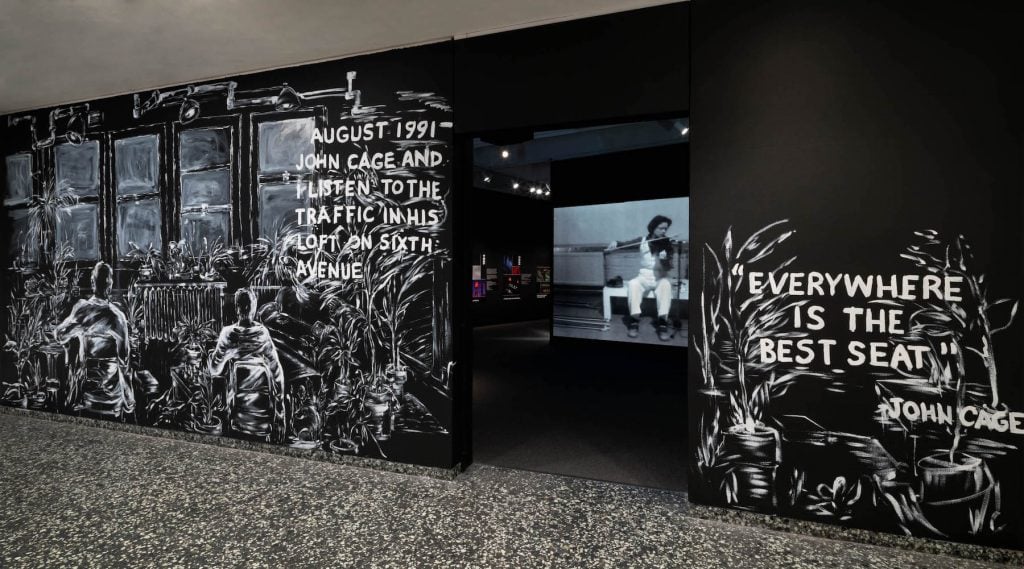
Installation view from “Laurie Anderson: The Weather” at the Hirshhorn Museum and Sculpture Garden, 2021. Courtesy of the artist. Photo by Ron Blunt.
Presenting her oeuvre in a gallery setting is an almost impossible task, so Anderson and curators Marina Isgro and Mark Beasley have opted instead to present a series of installations that follow some of her persistent themes. To make her multimedia practice suitable for gallery viewing, they have accentuated the visual.
Words—one of Anderson’s essential tools—are splashed over the walls in hand-written scrawls, shredded and rewoven in literal heaps of paper or plastered as long, printed texts on the walls of the gallery. Sound is another integral part of the exhibition, but often it comes second, taking the form of a soothing bath of words and music that operate as the exhibition’s soundtrack.
Anderson had hoped to include several VR works but was thwarted by Covid restrictions that prohibit the sharing of equipment. Instead, she transformed a 2017 VR work titled Chalkroom, created in collaboration with Taiwanese artist Hsin-Chien Huang, into a mesmerizing environmental installation that is the centerpiece of the Hirshhorn’s show.
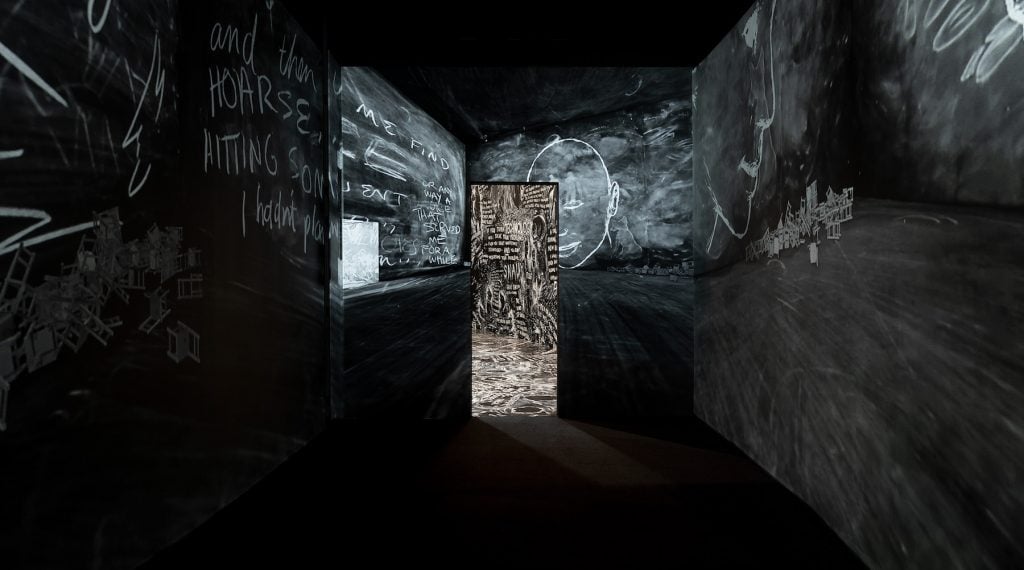
Laurie Anderson and Hsin-Chien Huang, Chalkroom (2017). Installation view from “Laurie Anderson: The Weather” at the Hirshhorn Museum and Sculpture Garden, 2021. Photo by Ron Blunt.
One enters through a doorway swept with moving projections of graffitied words and images that quite effectively mimic the sensation of moving through VR space. Inside, more images and words are scribbled in white paint on the black walls and floor. Unlike the projections, they are fixed in place, but the streams and eddies of white marks become almost as destabilizing as the moving images.
Reportedly, Anderson spent several weeks alone inside this room painting the texts and images herself. One on hand, they might be seen as a transliteration of the random thoughts and pictures snaking through her mind. But they also suggest the porous nature of the boundary between any internal consciousness and external stimuli.
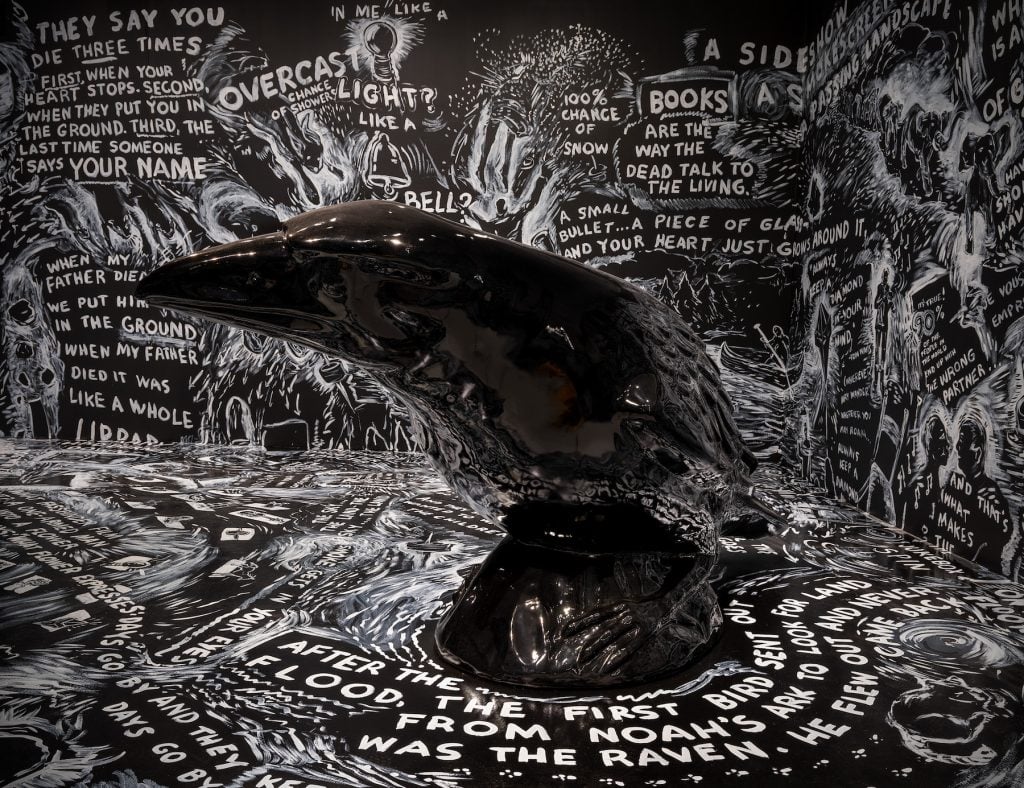
Laurie Anderson, The Witness Protection Program (The Raven) (2020). Installation view from “Laurie Anderson: The Weather” at the Hirshhorn Museum and Sculpture Garden, 2021. Courtesy of the artist. Photo by Ron Blunt.
The writing that spills over drawings of figures, landscapes, and objects has a stream-of-consciousness quality. It ruminates on the nature of death and dying: “They say you die three times. First when your heart stops. Second when they put you in the ground. Third, the last time someone says your name.” They present sardonic suggestions: “Once you’ve gotten the message, hang up the phone.” They ask questions: “What is the purpose of panic?” or “Who owns the moon?” And they quote figures like John Cage, Charles Dickens, the Beatles, Sigmund Freud, and the 13th-century Zen master Dogen.
Anchoring the swirling currents of words and images are three large sculptures created for this exhibition. A huge, black raven hunches ominously—a tribute both to the foreboding creature in Edgar Allen Poe’s eponymous poem and a Biblical reference to the bird sent out from the ark by Noah to look for life, never to return.
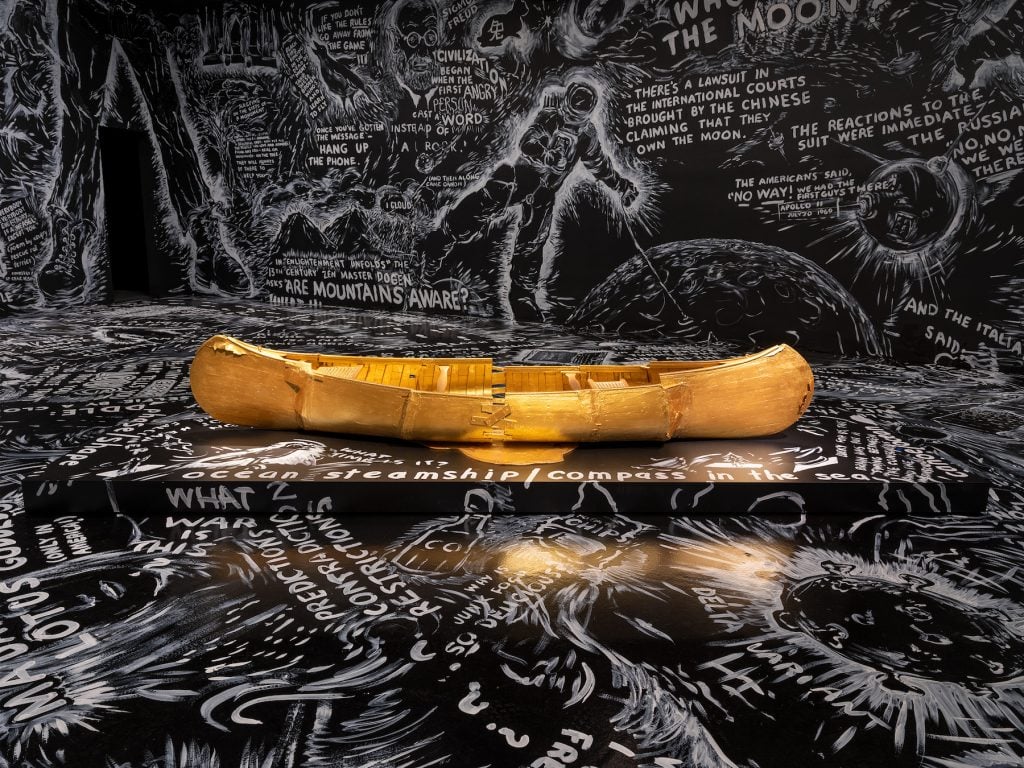
Laurie Anderson, To Carry Heart’s Tide (The Canoe) (2020). Installation view from “Laurie Anderson: The Weather” at the Hirshhorn Museum and Sculpture Garden, 2021. Photo by Ron Blunt.
A leaky and partially patched life-size gold canoe has been tasked, according to its title, To Carry the Heart’s Tide. A large green parrot with a moving beak clings to a metal perch. It is the source of a long eclectic monologue on the nature of things. Recited in a tinny electronic voice, its disjointed commentary converges at times with the written texts on the floor below.
A final sculpture is affixed to one wall. Titled What Time Can Do, it comprises a wooden shelf containing a lineup of various cups and vessels that shakes periodically as if from a passing train. It offers an illustration of a little parable, scrawled on the wall below, that describes the inevitable replacement of beautiful things with their most banal substitutes.
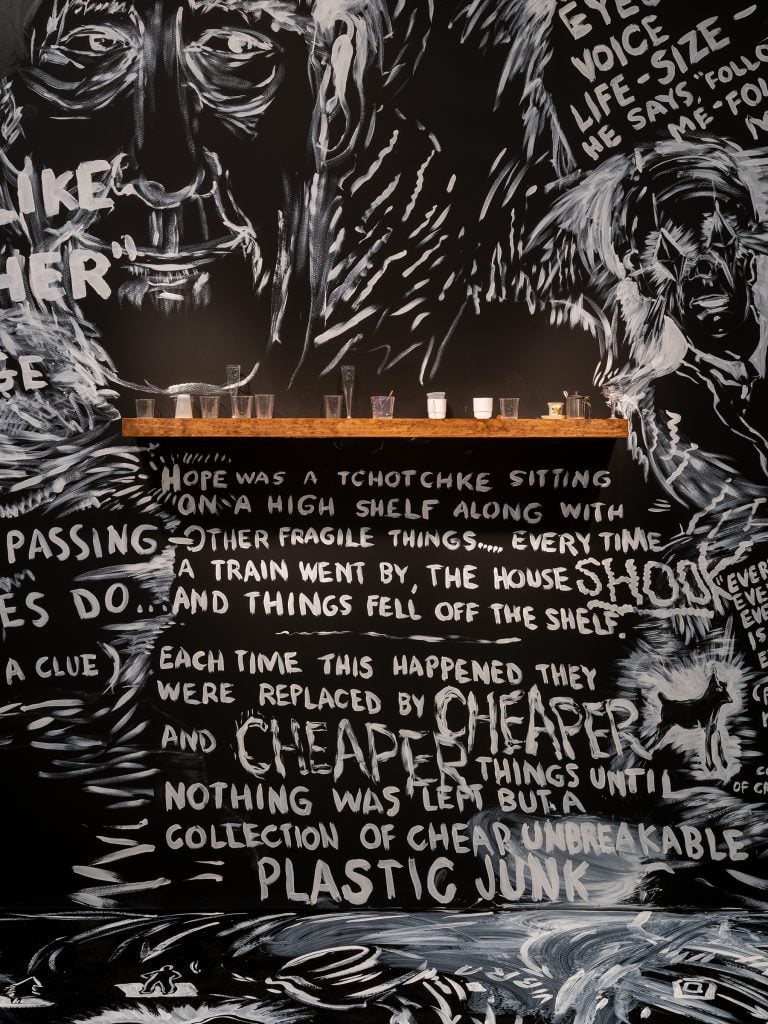
Laurie Anderson, What Time Can Do (Shaking Shelf) (2021). Installation view from “Laurie Anderson: The Weather” at the Hirshhorn Museum and Sculpture Garden, 2021. Photo by Ron Blunt.
None of the other works in the show have the razzle-dazzle of the Chalkroom. Nevertheless, there is plenty of food for thought. In a poignant story printed on one wall, a narrator (perhaps Anderson, perhaps not) recounts the sudden return of a lost memory of the constant presence of death in an ICU, where she spent several weeks as a child.
A row of tiny clay figures on which videos of real people have been projected create an enigmatic symphony as they wordlessly rub knives against a sharpening rod. A long bed of paper shredded from a copy of Crime and Punishment becomes the screen for flickering video clips of uncertain origin. A book contains Anderson’s version of the Bible created by a supercomputer that has mixed the sacred text with Anderson’s own writings. Darkly apocalyptic, it is full of vivid phrases and images that almost begin to cohere into a cogent text.
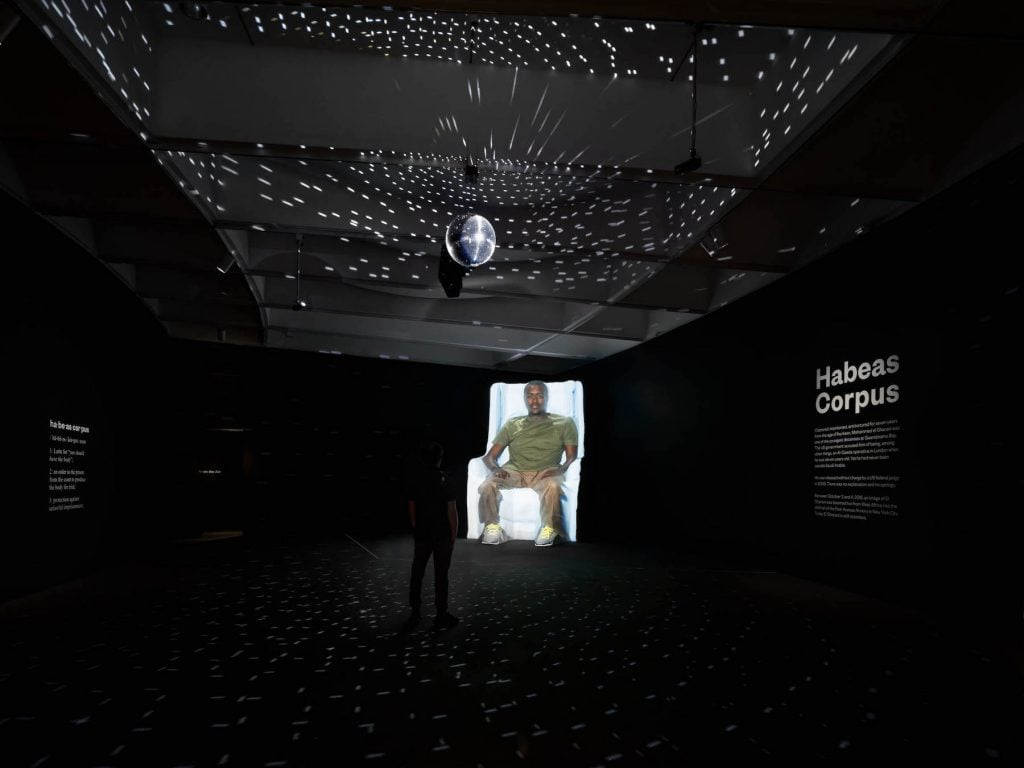
Laurie Anderson, Habeas Corpus (2015). Installation view from “Laurie Anderson: The Weather” at the Hirshhorn Museum and Sculpture Garden, 2021. Courtesy of the artist. Photo by Ron Blunt.
A sense of unease and anxiety permeates the show. This becomes overtly political in two works that reflect on one of this century’s darkest chapters. Habeas Corpus is a reinstallation of a 2015 work, originally created for the Park Avenue Armory, about Mohammed el Gharani, the youngest of the detainees imprisoned at Guantanamo Bay. Fourteen years old at the time of his capture, he spent seven years in captivity before he was finally released for lack of evidence. He remains haunted by memories of his incarceration and dogged by shadowy agents of various countries.
Because el Gharani is barred from entering the U.S., Anderson has him speaking about his ordeal through a projected image of him sitting in an armchair. In a particularly poignant moment, he recounts his visit to a slavery museum, where he recognized the essence of his experience in the shackles and cells on display.
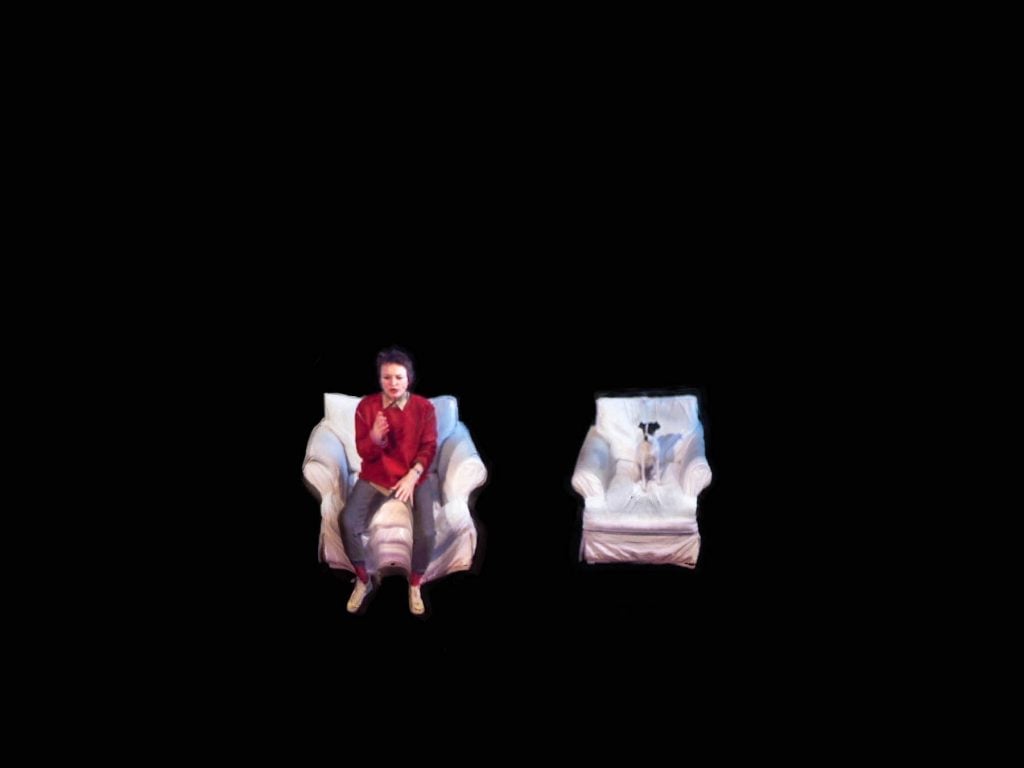
Laurie Anderson, From the Air (2009). Installation view from “Laurie Anderson: The Weather” at the Hirshhorn Museum and Sculpture Garden, 2021. Courtesy of the artist. Photo by Ron Blunt. Clay fabrication by Maria Dusamp.
A second work, From the Air (2009), provides the flip side to this tale of fear and insecurity. In a video projected over tiny clay figures of Anderson and her dog, she turns the tale of her beloved pet’s fearful reaction to a vulture attack into a parable about America’s heightened sense of vulnerability in the wake of the September 11 attacks.
While “The Weather” is billed as a non-retrospective, it doesn’t fully abandon the conventions of that format. There are posters and ephemera from various earlier projects, a selection of the rejiggered instruments Anderson has used over the years, and a set of video excerpts from selected performances from 1975 to 2018. Also included are a group of oil paintings that will evidently serve as backdrops for an upcoming performance. While competent expressionist abstractions in their own right, they seem out of place in this otherwise technology-driven show.
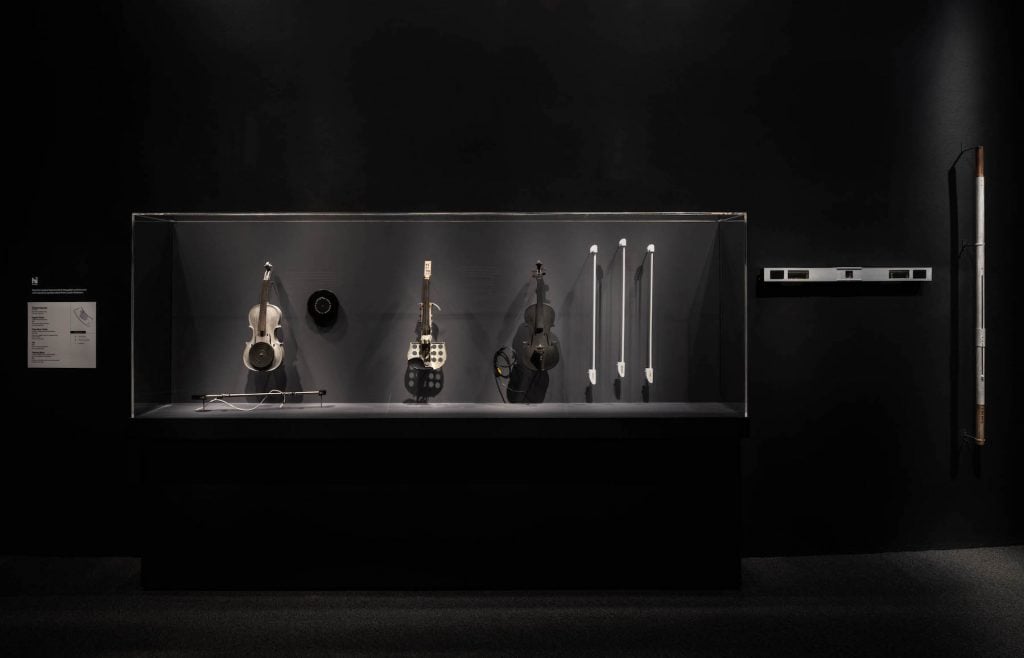
Installation view from “Laurie Anderson: The Weather” at the Hirshhorn Museum and Sculpture Garden, 2021. Courtesy of the artist. Photo by Ron Blunt.
More interesting are a group of staged photographs documenting a very early performance project. For the Institutional Dream Series, created 1972-73, Anderson had a friend photograph her as she attempted to sleep in various public places. Her stated purpose was to discover if location colors the nature of one’s dreams. But the project, with its images of Anderson curled up in such sites as public restrooms, a park bench and a beach, speaks to the origins of feminist performance art in the 1970s.
As exemplified by artists like Marina Abramovic, Ana Mendieta, and Valie Export, that style of performance encouraged interactivity and emphasized the physicality and vulnerability of the female body in a patriarchal society. Institutional Dream Series shares this sensibility, but Anderson would soon diverge from that kind of self-exposure. Instead, her work presents the body as an extension of ever more advanced technologies, as she experiments with synthesizers, Artificial Intelligence, and VR. Even when she performs on stage, her body seems a small thing, overtaken by an electronically enhanced voice that wants to flood the world.
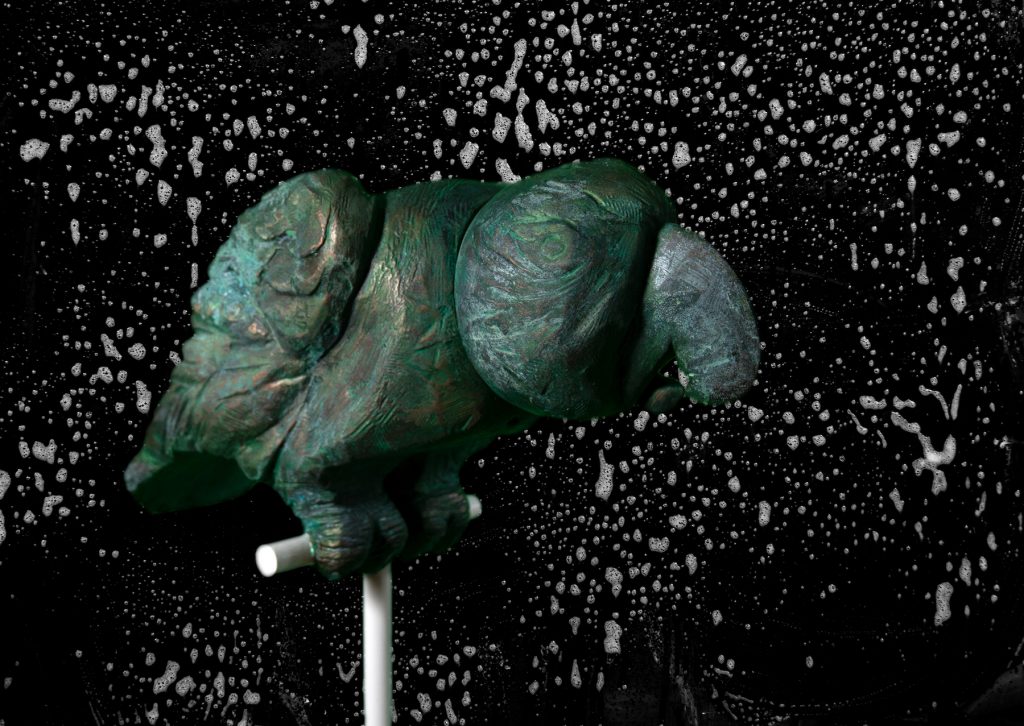
Laurie Anderson, My Day Beats Your Year (The Parrot) (2010/2021) on view in “Laurie Anderson: The Weather” at the Hirshhorn Museum and Sculpture Garden. Photo by Jason Stern.
All of which makes her the perfect artist for our immersive moment. Anderson speaks to an existence in which the physical body is merely a portal to other digital realities and identity is a construct made up, as Roland Barthes would say, of a tissue of signs and quotations from other centers of culture. Even in a museum setting where viewers go in person to interact with actual artworks, Anderson manages to evoke this brave new world where the corporeal is dissolving into the virtual.
Yet, despite the fact that “The Weather” celebrates a career that has relentlessly pursued the most advanced forms of electronic communication, ultimately Anderson seems to be presenting a cautionary tale. The marriage of real and virtual consciousness doesn’t seem to have made us any better or any smarter. Instead, Anderson has her nattering Parrot mutter: “They say that if you think technology can solve your problems, then you don’t understand technology and you don’t understand your problems.”
“Laurie Anderson: The Weather”, is on view at the Hirshhorn Museum and Sculpture Garden in Washington, D.C., through July 31, 2022.